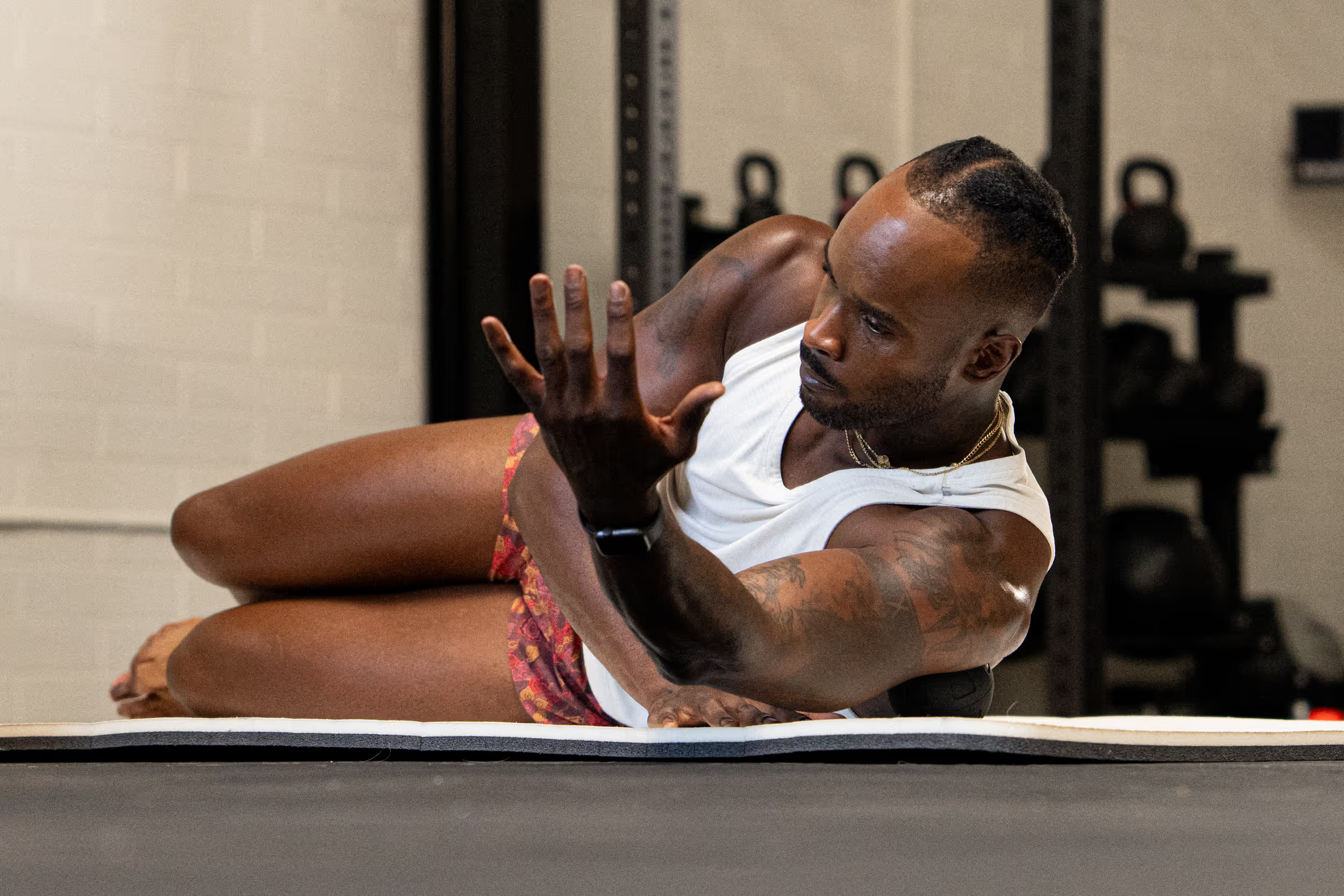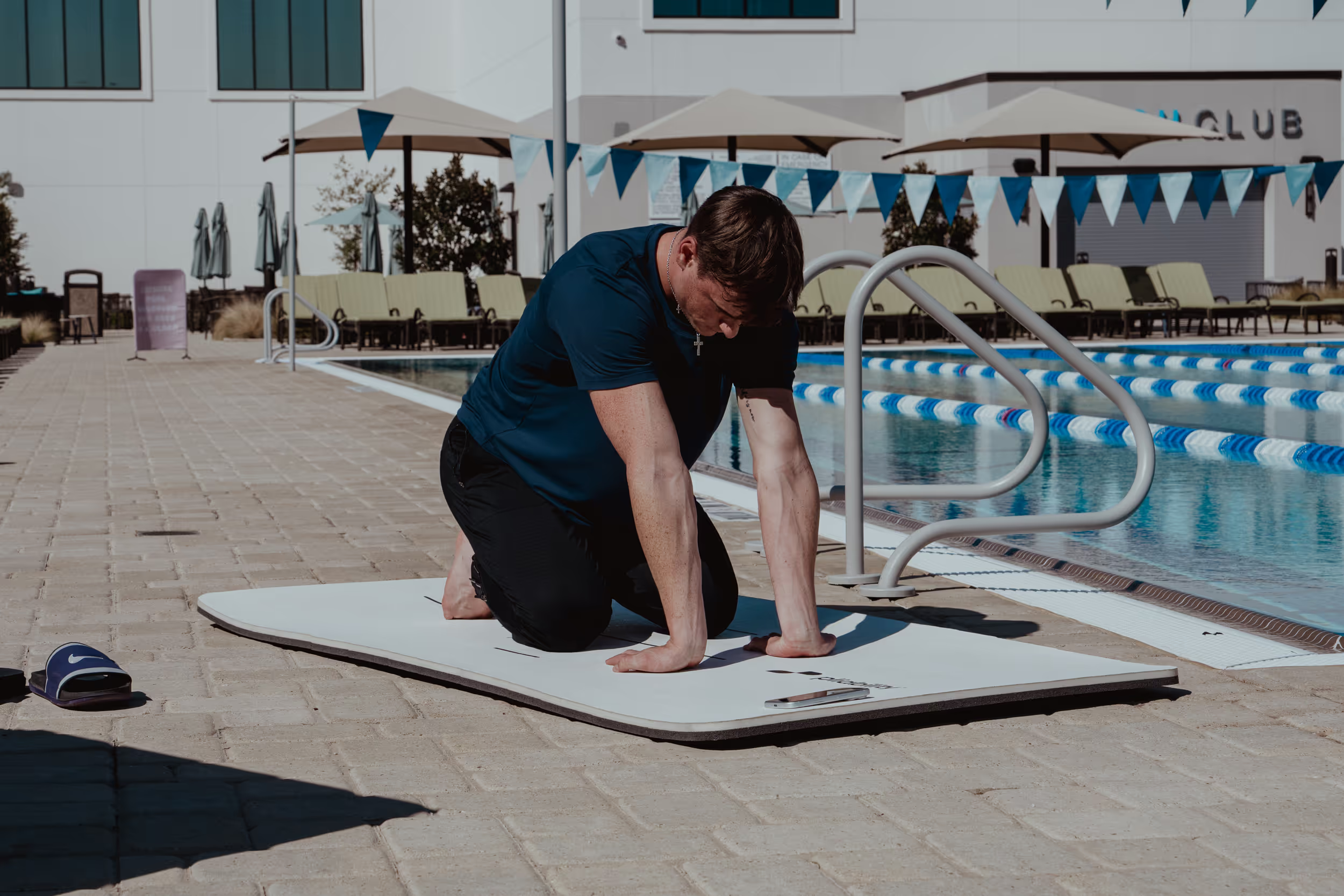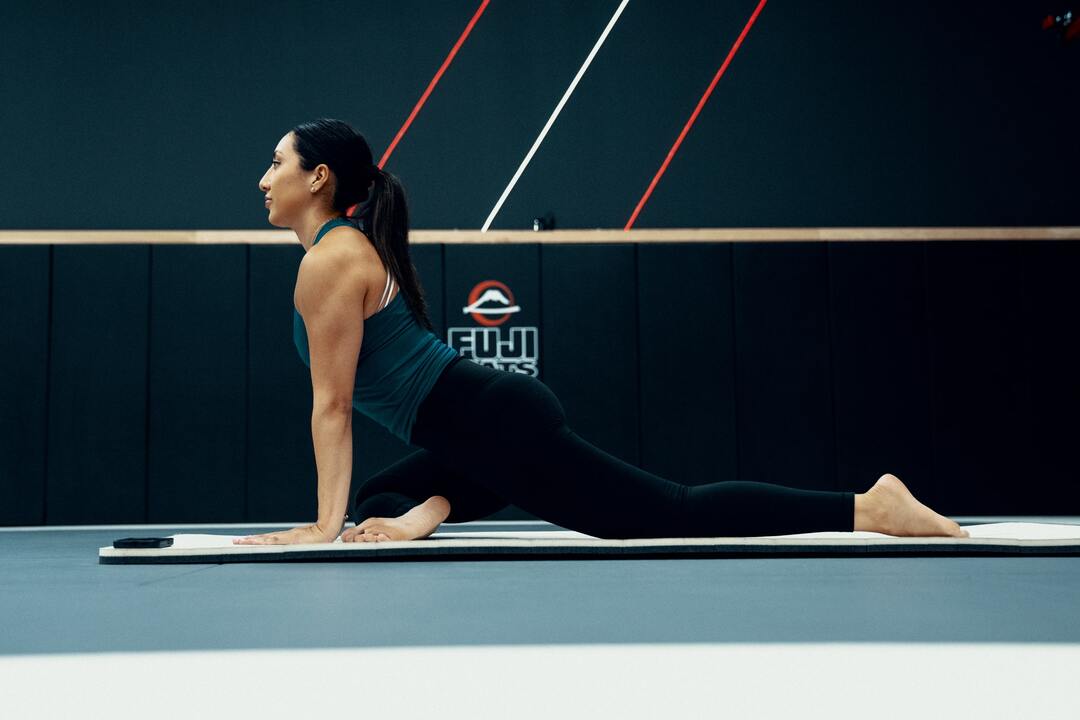You notice a dull pull along your forearm after a day of typing, racket practice, or lifting, and you wonder, Why Does My Forearm Feel Tight? Tight forearm muscles can manifest as gripping pain, wrist stiffness, or nagging tendon soreness, and they can hinder work, workouts, and everyday movement. This article combines simple anatomy, common causes such as overuse, muscle strain, and nerve irritation, with clear forearm stretches, trigger point moves, and mobility tips inspired by some of the best stretching exercises to quickly relieve forearm tightness, allowing you to move, work, and exercise comfortably again—without pain, stiffness, or recurring strain.
To help you put those ideas into practice, Pliability's mobility app offers short guided routines, step-by-step mobility drills, and targeted stretches you can do at your desk or after training to ease muscle tightness, restore wrist mobility, and reduce grip fatigue.
Why Does My Forearm Feel Tight?

Inside Your Forearm: Small Muscles that Move Your Hand
Under the skin of your forearm, many small muscles control your fingers, thumb, wrist, and help move your elbow. On the top side sit the extensors. They straighten the fingers and thumb. On the underside sit the flexors. They curl the fingers and thumb. Many of these muscles lie side by side and in layers, and several converge into common tendons at the elbow. That shared tendon link explains why tension in the forearm can show up as tennis elbow or golfer’s elbow.
Fascia: The Tight Wrapping You Rarely See
Fascia wraps each muscle, each muscle fiber, and even the myofibrils inside cells. It weaves into the muscle structure so you cannot really separate the muscle from the fascia. When fascia stays hydrated and mobile, muscles slide and move easily. When fascia becomes stiff or sticky, movement loses its smoothness, and the whole area feels tight.
Why These Muscles Fatigue So Fast
Those forearm muscles are relatively small and packed into a confined space. Repetitive hand work, long periods with the elbow bent, and constant gripping drive them to fatigue. Do you type, scroll, paint, sew, garden, climb, or lift weights a lot? Those activities require repeated flexion and extension, often holding the wrist in the same position for extended periods.
Tension from Lack of Recovery
Fatigue can cause irritation, which may feel like:
- Tightness
- Tenderness
- Stiffness
If you rest, those symptoms often ease within a day or two. If you repeatedly act without allowing for recovery, tension builds within the muscles and their fascia, and movement becomes increasingly limited.
Athlete Example: When Tightness Matters
In 2023, starting pitcher Max Scherzer left a game with forearm tightness. Elite athletes heed that signal because pushing through can turn a temporary tightness into a longer-term problem. He listened to his body and stopped playing with his forearm, which was irritated.
What Tight Forearms Can Lead To
Tight forearms can progress into several issues:
- Tennis elbow or lateral epicondylitis
- Golfer’s elbow or medial epicondylitis
- Muscle strains and sprains
- Pinched nerves, including carpal tunnel or nerve irritation up the arm
- Chronic exertional compartment syndrome, where pressure in the forearm compartments impairs blood flow
What Causes Forearm Fatigue and Tightness
Typical causes include repetitive keyboard and mouse use, constant scrolling, and activities that require heavy gripping, such as sports or hobbies like sewing, painting, or gardening. Holding the elbow bent for long periods adds stress. Repetition can lead to muscle fatigue, which may then result in irritation.
Escalation of Musculoskeletal Tension
Early signs are a pumped or hard feeling, tenderness, and stiffness. Rest usually reverses this in 24 to 48 hours. Repeating the activity without recovery allows tension to accumulate in the muscle and fascia, which gradually loses fluid and elasticity, becoming stiff. That change can limit wrist and finger motion, as well as reduce grip strength. Some people describe sharp, nervy pain, numbness, or difficulty gripping as the condition worsens.
Common Causes of Forearm Tightness
1. Post Activity Tightness and Delayed Soreness
After a hard workout or a long day of manual work, you may feel straightforward tightness. Mild inflammation causes tenderness and stiffness that commonly eases in 24 to 48 hours. This short-term soreness is part of how muscles adapt and strengthen.
2. Muscle Imbalance and Poor Posture
When flexors dominate and extensors lag, the forearm can tighten on one side. Repeated curling motions without counter work create imbalance and shorten specific muscles.
3. Grip Intensive Work or Training
Climbers, mechanics, and weightlifters place heavy, repeated demand on gripping muscles and tendons. Those jobs and sports produce chronic fatigue in the forearm.
4. Nerve or Tendon Irritation
Tendonitis and nerve compression can cause the forearm to feel tight, even at rest. Conditions such as tennis elbow, carpal tunnel syndrome, and nerve irritation at the neck or elbow can present as tightness and numbness.
5. Continuous Loading Without Recovery
Loading the forearm day after day without rest breeds chronic tightness. You may experience reduced wrist flexibility, feel stiff fingers, and notice some discomfort in your elbow. The immediate pumped feeling may fade, but the imbalance persists.
6. Tightness Driven by Nerve Tension
When nerves that supply the forearm become irritated or compressed, the muscles they serve can tighten. This neuromuscular tightness may present as early fatigue, worsened symptoms with certain neck positions, and pain or numbness that does not resolve with rest.
7. Increased Compartment Pressure
Elevated pressure inside forearm compartments reduces blood flow, leading to a painful tightness that occurs during gripping tasks and eases with rest. This pattern is characteristic of chronic exertional compartment syndrome.
8. Arthritis Around the Wrist or Elbow
Arthritis wears down joint cartilage, causing bones to rub against each other. Joint stress can cause surrounding muscles to tighten and protect the area, resulting in forearm stiffness.
9. Muscle Weakness and Overuse
Weak muscles must work harder and fatigue earlier. Repeated heavy work without enough recovery worsens tightness and reduces endurance.
10. Stretch Reflex and Protective Tension
When a muscle feels vulnerable, the nervous system resists sudden lengthening. If you continue to stretch a tired or inflamed forearm, the nervous system can increase muscle tone, exacerbating the tightness and creating a frustrating loop.
Symptoms You Might Notice
- A feeling of tightness or reduced range of motion in the wrist and fingers.
- Forearm fatigue during routine tasks or light workouts.
- A dull ache, often localized to one arm.
- Tenderness when pressing into the muscle or near the elbow tendon.
- A pulling sensation when you extend the wrist or fingers.
- Sharp, nervy pain, pins and needles, numbness, or a loss of grip strength.
Do You Notice Numbness When Gripping or Pins and Needles When You Type?
When is forearm pain an emergency? Seek prompt medical care if you have any of these red flags:
- Sudden severe pain or inability to move the arm.
- Numbness or tingling that is new or worsening.
- Swelling accompanied by fever, chills, or a hot joint suggests an infection.
- Pain that occurs with exercise and stops at rest in a predictable pattern which can indicate vascular or compartment issues.
- A snapping sound at the time of injury, visible deformity, or extreme pain that suggests a fracture or major tendon rupture.
If pain persists for more than a few weeks without improvement, consult your doctor for an assessment and to explore treatment options, such as specific stretching, targeted strengthening, ergonomic adjustments, manual therapy, or imaging when necessary.
Related Reading
- Why Do I Have Trouble Walking After Sitting
- Why Am I Sore After Stretching
- What Do Tight Muscles Look Like
- Why Do Muscles Get Tight
- Why is Hip Mobility Important
- How Can Stiff and Tight Muscles Result in Back Pain?
- Why is My Back So Stiff
- Why Are My Shoulders So Tight
- How to Prevent Morning Stiffness
How to Relieve Tight Forearm Muscles

Forearm tightness can result from local muscle overload, tendon irritation, or nerve irritation higher up, where arm nerves exit the neck. Fascia and muscle patterns pull through the shoulder and chest, so the spot where you feel tightness is not always the source of the problem.
Ask yourself: Do you also notice neck stiffness, shoulder aches, numbness in your fingers, or trouble lifting objects above your head? If so, include gentle neck mobility exercises and assess posture as part of the plan.
Take Regular Breaks and Reduce the Aggravating Activity
If you do repetitive work or sport, schedule short pauses. Every 20 to 30 minutes, take a microbreak of 30 to 60 seconds to stretch the wrist and open the hand. Take a 3- to 5-minute break every hour to move your shoulders and neck. If symptoms flare during an activity, stop or reduce the volume for a few days and substitute lower-demand tasks while treating the area.
Stretch Routine to Loosen Forearms: Short Holds and Frequent Reps
Start with your forearm supported on a table and use your opposite hand to assist. Hold each stretch 15 to 20 seconds and repeat 3 to 5 times. Shorter holds are often repeated to increase blood flow and mobility without causing extra irritation.
Wrist Extensor Stretch
- Extend your arm out at shoulder height or rest it on a table, palm down.
- Use the opposite hand to pull the hand down and toward the body until you feel the stretch on the back of the forearm.
How long: 15 to 20 seconds.
Reps: 3 to 5 each side.
What to expect: A gentle pull, not sharp pain.
Wrist Flexion Stretch
How to do it:
- Arm straight without locking the elbow.
- Bend the wrist so fingers point down.
- Use the opposite hand to gently pull the fingers toward your body until you feel a stretch on the inside of the forearm.
How long: 15 seconds.
Reps: 5 times, four times a day, 5 to 7 days a week.
What to expect: A mild stretch across the flexor muscles and tendon area.
Elbow Bend Mobility
- Stand straight and bend one arm so the palm touches the shoulder or as close as you can reach.
- Hold for a few seconds, then lower.
Reps: 10 times.
How long: Daily when stiffness is present.
What to expect: Increased elbow range and less stiffness around the distal biceps and proximal forearm.
Wrist Turn for Rotation and Grip Coordination
How to do it:
- Hold a water bottle or soup can at shoulder height.
- Start with your palm facing up and slowly turn it to face down, then back.
Sets and reps: 3 sets of 10 repetitions
Progression: Increase weight or range as comfort allows.
What to expect: Improved pronation and supination, less catching or a tight feeling when twisting the wrist.
Progression Plan for Stretches and Resisted Work
How to do it:
- Begin all repetitions with the forearm supported on a table and use the opposite hand to assist when needed.
- When you can do 30 reps for two consecutive days without pain, add a 1-pound weight.
- Repeat the same rule to progress to 2 pounds and then 3 pounds.
Next phase: Do the exercise without the opposing hand.
Final phase: Perform without table support. Move slowly through these phases to minimize flares.
Strengthening to Build Endurance for Sport and Daily Tasks
Strength training reduces overload and helps prevent conditions such as:
- Tennis elbow
- Golfer’s elbow
- Other overuse injuries
Start without weight, use slow, controlled motions, and follow the same 30-rep progression plan described above. Keep the eccentric lowering slow—three seconds down—because this helps build tendon tolerance.
Wrist Extension Strengthening
- Forearm supported on a table with the wrist at the edge, palm down.
- Bend the wrist upward using the opposite hand for assistance, if needed. Hold for one second, then slowly lower for three seconds.
Reps: 30 per day, 5 to 7 days a week.
What to expect: Less fatigue during gripping tasks over weeks.
Wrist Flexion Strengthening
- Elbow at 90 degrees with forearm supported and palm up.
- Bend the wrist upward, hold for one second, then lower slowly for three seconds.
Reps: 30 per day, 5 to 7 days a week.
What to expect: Stronger grip and more balanced forearm muscles
Use a Massage Ball or Foam Roller to Break Up Tight Fascia
How to do it:
- Use a lacrosse ball or foam roller on the forearm muscles.
- Roll slowly along the muscle belly and stop on tender spots for 20 to 40 seconds. Work 1 to 3 minutes per area, adjusting pressure to stay in a tolerable ache.
What to expect: Reduced focal tightness and better sliding between muscle layers. Avoid sharp shooting pain or numbness; adjust your technique if these symptoms occur.
Heat and Cold Therapy for Targeted Relief
How to do it:
- Use moist heat or a warm pack for 10 to 15 minutes before stretching to soften the tissue and improve range of motion.
- Use ice or a cold pack for 10 to 15 minutes after engaging in heavy activity or experiencing an acute flare and inflammation.
What to expect: Heat eases stiffness and improves tolerance for movement; cold reduces acute swelling and pain.
Contrast Baths for Circulation and Inflammation Control
How to do it:
- Soak forearms in hot water for 3 minutes, then cold water for 1 minute.
- Repeat the cycle 3 to 4 times.
What to expect: Improved local blood flow, decreased stiffness, and temporary relief of soreness.
Self Myofascial and Trigger Point Release for Stubborn Spots
How to do it:
- Press a small firm ball into a tight spot and hold steady pressure for 20 to 40 seconds.
- Gently move the wrist through small ranges while maintaining pressure.
Frequency: Apply once or twice daily to problem areas
What to expect: Tender areas will soften, and pain referral may decrease as fascial restrictions are released.
Improve Ergonomics to Reduce Nerve and Muscle Overload
How to do it:
- Keep your wrists neutral while typing.
- Position the keyboard and mouse to avoid reaching.
- Adjust the chair height so that your shoulders remain relaxed.
- Use a wrist support if needed. Take the breaks described earlier and vary tasks during the day. What to expect: fewer spikes of pain and less afternoon fatigue.
Balance the Opposite Muscle Group
How to do it:
- Add reverse curls, wrist extensions, and varied grip work to your routine to strengthen both flexors and extensors simultaneously.
- Use light weights and the same slow eccentric tempo.
What to expect: Reduced imbalance that can cause tendon overload and recurrent forearm tightness.
Rest, Sleep, and Recovery Matter
How to do it:
- Reduce your activity level enough to allow the inflamed tissues to calm. Prioritize good sleep and avoid repetitive loading for a few days when pain is sharp.
What to expect: Pain and tightness usually ease with short periods of reduced aggravation and improved rest.
When to seek professional help: Red flags and referrals
Red Flags for Worsening Injury
See a doctor or physical therapist if pain persists beyond two to three weeks despite self-care, if you have worsening numbness or burning in the fingers, weakness or dropping objects, severe night pain, or sudden loss of function. Seek urgent care for signs of infection, severe swelling, or sudden severe loss of movement.
A clinician can assess for nerve compression, tendon tears, cervical radiculopathy, or other conditions and guide targeted manual therapy, nerve gliding exercises, guided rehabilitation, or imaging as needed.
Safety Notes and Warning Signs During Exercises
Stop or reduce intensity if you get sharp, electric pain, new numbness, or progressive weakness. Use pain as a guide: A mild to moderate ache during work is acceptable, but increasing pain that lasts more than 24 hours after exercise indicates it's time to reassess and consult a clinician.
Related Reading
- Stiff Feet in the Morning
- How Can Poor Posture Result in Back Pain?
- How Long Stiff Neck Last
- Stiff Feet in the Morning
- Why Does My Knee Feel Stiff
- How to Treat Stiff Fingers in the Morning
- Joint Stiffness in the Morning
- What to Do for Tight Muscles
- Why Are My Calf Muscles So Tight
- How to Loosen Tight Muscles in Legs
- How to Loosen Tight Lower Back Muscles While Standing
What Can You Do to Prevent Tight Forearms?

Many people reach for long holds when their forearm feels tight. Stretching can sometimes help, but if tightness stems from overuse, nerve irritation, or protective muscle guarding, stretching addresses the symptom rather than the underlying cause. Stretching inflamed tissue can increase irritation and slow recovery, so pause aggressive stretching when the area feels:
- Hot
- Sharp
- Unusually sensitive
How Repeated Stretching Can Make Sensitivity Worse
When you repeatedly push a sore forearm into a stretch, the nervous system can grow more reactive. That creates more tension, increased pain, and that familiar tight forearm sensation that never fully resolves. This effect is commonly observed in chronic repetitive strain injuries, such as:
- Carpal tunnel syndrome
- Tennis elbow
- Cubital tunnel syndrome
Why Too Much Stretching Can Reduce Strength and Control
Forearm muscles stabilize the wrist and fingers during fine tasks. Excessive static stretching can blunt the neuromuscular signals those muscles use for precise work, reducing grip strength and joint control. If you need your hands for typing, manual work, or sports, losing stability increases your risk of strain and dropping objects.
Strength Instead of Stretching: What to Do and How Much
Many people who feel tight actually benefit from strengthening, not more stretching. Utilize low-load and high-rep work to build tolerance and enhance blood flow.
- Wrist curls and wrist extension with light dumbbells: 2 to 3 sets of 15 to 25 reps. Move slowly and control both directions.
- Finger resistance with therapy putty or rubber band: 2 sets of 15 to 30 reps for finger spread and finger flexion.
- Grip holds with a stress ball or hand gripper: 3 holds of 20 to 40 seconds. Use a load that feels challenging but not painful.
Progress by adding reps, sets, or slightly more resistance over weeks. Those exercises reeducate muscle firing and tell the nervous system the forearm is safe to load.
Active Mobility Drills That Improve Movement Without Overstretching
Swap long static holds for controlled motion through the full range of motion.
- Wrist circles and figure eights: 10 to 20 slow reps each direction.
- Forearm pronation and supination with a light weight or hammer: 2 sets of 15 each way.
- Nerve glides for the median nerve: Gentle flossing motions, 8 to 12 reps without sharp symptoms.
These drills increase circulation and restore coordinated movement without triggering stretch reflexes that can cause muscle spasms or lock you up.
Tackling Trigger Points and Myofascial Restrictions
Knots in the forearm can feel like tightness even when the muscle length is standard. Try focused release techniques.
- Lacrosse ball rolls along the forearm for 1 to 2 minutes. Work slowly and stop if it produces sharp or thunderous pain.
- Gentle cross-friction massage across common tendons using your thumb or fingers for 30 to 60 seconds.
- Percussion tools used lightly for short periods can reduce local tone.
Use gentle pressure and follow with gentle movement to allow the tissue to settle into improved motion.
Breaks, Task Design, and Workstation Setup You Can Start Today
Small changes reduce repetitive strain and prevent the forearm from locking up.
- Take a short break every 30 to 45 minutes. Do gentle wrist rolls, shake your hands, and move your shoulders.
- Keep wrists neutral while typing. Position the keyboard and mouse so your forearm aligns with your hand without bending up or down.
- Adjust the chair and monitor height so that your shoulders are relaxed. If your mouse sits too high or too low, you will compensate by adjusting the tension down the chain.
- Avoid clenching. Rest fingers lightly between tasks and try a posture check every 20 minutes.
Microbreaks of one to two minutes, done frequently, can help prevent forearm pain by beating one long stretch at the end of the day.
Daily Strength and Mobility Routine That Fits a Busy Schedule
Consistency beats intensity. Short, frequent sessions give better results than occasional long workouts.
- Morning quick start: 5 minutes of wrist circles, forearm pronation and supination, and 10 gentle nerve glides.
- Midday micro session: 2 to 3 minutes of finger resistance or grip holds during a break.
- Two times per week: 15 minutes of light wrist and finger strengthening as listed above.
These small investments maintain blood flow, reinforce healthy movement patterns, and decrease episodes of wrist stiffness and hand cramps.
Addressing the Chain Above the Forearm to Remove Compensation
Forearm tightness often comes from higher up. Release restrictions in the neck, shoulders, and upper back.
- Scapular work, such as wall slides and rows, to build shoulder control.
- Thoracic extensions over a foam roller for posture and breathing.
- Neck mobility drills to prevent shoulder elevation and arm guarding.
Improving movement upstream reduces compensatory overuse in the wrist and forearm.
When to Ease Up on Stretching and When to Back Off Completely
Stop aggressive stretching if you feel sharp pain, tingling, numbness, or a burning sensation that spreads. Those signs suggest nerve irritation or inflammation, and stretching can increase sensitivity. Gentle mobility and light strengthening often provide more benefit in these cases.
Red Flags That Need Professional Assessment
See a clinician if symptoms last more than a few weeks despite home care or if you have:
- Numbness
- Persistent tingling
- Weakness
- Dropping objects
- Severe night pain
A physical therapist or occupational therapist can test for nerve entrapment, tendinopathy, or structural issues and prescribe targeted rehab.
A hand specialist or neurologist can arrange nerve studies if testing indicates conduction problems.
Related Reading
- Can Tight Hips Cause Knee Pain
- How to Loosen Tight Forearm Muscles
- Why Do My Legs Feel Tight and Heavy
- What Causes Stiff Neck
- How to Loosen Tight Jaw Muscles
- Why Do My Hands Feel Tight
- How to Loosen Tight Hips and Lower Back
- How to Loosen Tight Scalp Muscles
Improve Your Flexibility with Our Mobility App Today | Get 7 Days for Free on Any Platform

Pliability treats yoga as a tool for athletes and performance-minded people. The app offers a vast library of high-quality videos that focus on mobility, flexibility, recovery, range of motion, and pain reduction. Daily updated custom mobility programs adjust to your training load and recovery needs, while guided sessions teach joint-friendly movement and soft tissue care for tight muscles and restricted joints. You can sign up for a free seven-day trial on iPhone, iPad, Android, or on the website.
Why Does My Forearm Feel Tight and What Causes It
Does your forearm feel tight after long typing sessions, heavy lifting, or racket work? Tightness often stems from overuse and repetitive strain of the forearm flexors and extensors, constant gripping, poor wrist posture, or sudden increases in load. Conditions like tendonitis, tennis elbow, golfer's elbow, nerve compression, including carpal tunnel, trigger points, and poor circulation all produce a sense of:
- Tightness
- Burning
- Reduced grip strength
Stiffness can follow delayed onset muscle soreness after a challenging workout or come from chronic postural patterns at a desk.
Quick Checks to Pinpoint the Problem
Ask a few simple questions to narrow the cause. Does the tightness worsen with gripping or wrist extension? Do you feel tingling in the fingers or numbness at night? Is the pain localized near the lateral elbow or the medial elbow? Try basic range checks: full wrist flexion and extension, resisted wrist flexion and extension, and a simple pinch test for grip.
Those results guide whether you focus on soft tissue release, tendon rehab, nerve gliding, or posture correction.
Simple Forearm Mobility and Stretching Routine You Can Do Now
Begin with a brief warm-up to increase blood flow: perform wrist circles and gentle wrist pumps for 60 seconds. Then follow a few targeted moves.
- Wrist extensor stretch: Extend your arm, palm down, and pull the fingers back with the other hand. Hold for 20 to 30 seconds while breathing.
- Wrist flexor stretch: Extend arm, palm up, pull fingers back, and hold for 20 to 30 seconds.
- Pronation and supination swings: Elbow at side, rotate palm up and down slowly 10 to 15 times.
- Finger flexor release: Press your palm on a table and lift fingers individually for 8 to 12 reps.
- Eccentric wrist lowering: hold a light weight and lower the wrist slowly for three sets of 10 for tendon rehab.
Finish with 60 seconds of relaxed grip and foam rolling across the forearm muscles if you feel tight knots.
Nerve Glides and Soft Tissue Options for Persistent Tightness
If tingling or numbness accompanies tightness, add median and radial nerve glides to reduce entrapment and restore mobility. Gentle soft tissue work, such as massage with a massage ball or a therapist, combined with progressive eccentric strengthening, helps alleviate tendon pain and chronic stiffness. Keep loads controlled and increase slowly to avoid flare-ups.
How Pliability Builds Programs That Target Forearm Tension
Pliability uses short assessment sequences and your feedback to craft daily updated programs that target problem areas like forearms, wrists, shoulders, and thoracic spine. The sessions mix mobility drills, active stretching, breathing cues, and strengthening where needed. Video instruction demonstrates the correct loading, hand placement, and tempo, protecting tendons and nerves while improving range of motion.
Body Scan That Finds Asymmetries and Restricted Joints
The body scanning feature maps joint ranges and muscle restrictions to find asymmetric movement or hidden tight spots in the forearm chain. It highlights limited wrist extension, reduced pronation and supination, or shoulder restrictions that force compensations into the forearm.
The app then recommends focused routines that prioritize releases, nerve mobility, and progressive joint loading.
Integrating Mobility With Training and Desk Life
Short mobility sessions are more effective than infrequent long ones. Incorporate five to ten-minute breaks throughout the workday to reset wrist posture and release grip tension. Add 10- to 20-minute sessions after training to speed recovery and reduce the delayed onset of stiffness.
For rehabilitation, follow a clinician-guided plan and use the app to track consistency, changes in pain, and improvements in range of motion.
Who Benefits Most and When to Seek Professional Care
Athletes, strength trainers, desk workers, musicians, and anyone who grips repeatedly will see gains from consistent mobility work and targeted stretching. If you have sharp pain, worsening numbness, or progressive weakness in the hand, see a clinician for diagnostic testing and a structured rehab plan rather than only self-treatment.
Try Seven Days Free on Any Device
Sign up for seven days absolutely free on iPhone, iPad, Android, or on the website to experiment with sport-specific mobility plans and forearm-focused routines that aim to improve flexibility, aid recovery, reduce pain, and increase range of motion.








